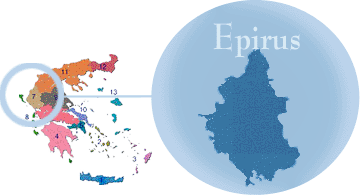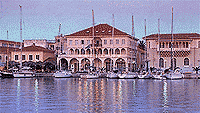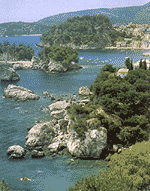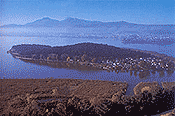
Coastal region of northwestern Greece and southern Albania. It extends from Valona Bay in Albania (northwest) to the Gulf of Arta (southeast); its hinterland extends eastward to the watershed of the Pindus Mountains. The departments of Arta, Ioannina, Preveza, and Thesprotia make up the Greek part of Epirus. The Pindus Mountains separate Epirus from the Greek regions of Macedonia and Thessaly to the east.  The principal town in Greek Epirus is Ioannina, and the largest settlement in Albanian Epirus is Argirokastro. Epirus is largely made up of great limestone ridges oriented northwest-southeast and north-south; they reach up to 8,600 feet (2,600 m) in height and fall off more steeply to the west. These ridges generally parallel the coast and are so steep that the valley land between them is mostly suitable only for pasture, though northern Epirus has more plains and cereal production. Much of Epirus lies on the windward side of the Pindus Mountains and hence receives the prevailing winds off the Ionian Sea, with the result that it receives more rainfall than does any other region of mainland Greece. Poor-quality soils, faulty farming practices, and fragmented landholdings have kept the region's agricultural productivity low. Sheep and goats are raised, and corn (maize) is the chief crop. Olives and oranges are also cultivated, and tobacco is grown around Ioannina. There is also some dairying and fishing. Wheat and vegetables must be imported. Epirus has few resources and industries, and its population has been depleted by emigration.
The principal town in Greek Epirus is Ioannina, and the largest settlement in Albanian Epirus is Argirokastro. Epirus is largely made up of great limestone ridges oriented northwest-southeast and north-south; they reach up to 8,600 feet (2,600 m) in height and fall off more steeply to the west. These ridges generally parallel the coast and are so steep that the valley land between them is mostly suitable only for pasture, though northern Epirus has more plains and cereal production. Much of Epirus lies on the windward side of the Pindus Mountains and hence receives the prevailing winds off the Ionian Sea, with the result that it receives more rainfall than does any other region of mainland Greece. Poor-quality soils, faulty farming practices, and fragmented landholdings have kept the region's agricultural productivity low. Sheep and goats are raised, and corn (maize) is the chief crop. Olives and oranges are also cultivated, and tobacco is grown around Ioannina. There is also some dairying and fishing. Wheat and vegetables must be imported. Epirus has few resources and industries, and its population has been depleted by emigration.  The population is concentrated in the area around Ioannina, which has the largest number of manufacturing establishments.
The population is concentrated in the area around Ioannina, which has the largest number of manufacturing establishments.
In the Neolithic period Epirus was populated by seafarers along the coast and by shepherds and hunters from the southwestern Balkans who brought with them the Greek language. These people buried their leaders in large mounds containing shaft graves. Similar burial chambers were subsequently used by the Mycenean civilization, suggesting that the founders of Mycenae may have come from Epirus and central Albania. Epirus itself remained culturally backward during this time, but Mycenean remains have been found at two religious shrines of great antiquity in the region: the Oracle of the Dead on the Acheron River, familiar to the heroes of Homer's Odyssey, and the Oracle of Zeus at Dodona, to whom Achilles prayed in the Iliad. After the Mycenaean civilization declined, Epirus was the launching area of the Dorian invasions (1100-1000 BC) of Greece. The region's original inhabitants were driven southward by the Dorians, and out of the ensuing migrations three main clusters of Greek-speaking tribes emerged in Epirus: the Thesproti of southwestern Epirus, the Molossi of central Epirus, and the Chaones of northwestern Epirus. They lived in clusters of small villages, in contrast to most other Greeks, who lived in or around city-states. In the 5th century Epirus was still on the periphery of the Greek world. To the 5th-century historian Thucydides, the Epirotes were "barbarians." The only Epirotes regarded as Greek were the Aeacidae, who were members of the Molossian royal house and claimed descent from Achilles. From about 370 BC on, the Aeacidae were able to expand the Molossian state by incorporating tribes from the rival groups in Epirus. The Aeacidae's efforts gained impetus from the marriage of Philip II of Macedon to their princess, Olympias. In 334, while Alexander the Great, son of Philip and Olympias, crossed into Asia, his uncle, the Molossian ruler Alexander, attacked southern Italy, where he was eventually checked by Rome and killed in battle in about 331. Upon Alexander the Molossian's death, the Epirote tribes formed a coalition on an equal basis but with the Molossian king in command of their military forces. The greatest Molossian king of this coalition was Pyrrhus (319-272); he and his son Alexander II ruled as far south as Acarnania and to central Albania in the north.
Pyrrhus' military adventures overstrained his state's military resources, but they also brought great prosperity to Epirus. He built a magnificent stone theatre at Dodona and a new suburb at Ambracia (now Arta), which he made his capital. After the Aeacid monarchy ended in 232, the Epirote alliance was transformed from a coalition of tribes into a federal state, the Epirote League, with a parliament (synedrion). The league steered an uneasy course during the conflicts between Rome and Macedonia, and in 170 BC, during the Third Macedonian War (171-168), the league split apart, the Molossians supporting Macedonia, the Chaones and Thesproti siding with Rome. Molossia was taken in 167 by victorious Rome, and 150,000 of its inhabitants were enslaved. (see also Index: Roman Republic and Empire) Central Epirus did not recover until the Byzantine period, but the coastal areas continued to prosper as part of a Roman province. When the Roman Empire split in AD 395, Epirus was the westernmost province of the Eastern Empire. When the Byzantine Empire became fragmented, an independent kingdom was maintained in Epirus (see Epirus, Despotate of) after 1204 AD, but in 1318 Serbs and Albanians overran the area, and in 1430 the Ottoman Turks annexed it. Under Turkish rule, the region suffered from overcultivation and deforestation that caused soil erosion and depopulation. In the 18th century Turkish sovereignty over Epirus was threatened by a Turko-Albanian despot, Ali Pasa Tepelen, who was recognized in 1778 by Turkey as pasha of Ioannina. His oppressive rule was extended by 1810 to most of the Peloponnese, central Greece, and parts of western Macedonia and was a leading cause of the War of Greek Independence (1821-29). Much of northern Epirus was united with Greece in 1913, leaving minorities on both sides of the Greek-Albanian frontier. In 1939 Italy annexed all of Albania but in 1940, after attempting to invade Greece, was pushed out of Greek Epirus by the Greek army and lost much of northern Epirus until the German attack on Greece. The German occupation followed (1940-44) until the Allies restored the Greek-Albanian frontier.
He built a magnificent stone theatre at Dodona and a new suburb at Ambracia (now Arta), which he made his capital. After the Aeacid monarchy ended in 232, the Epirote alliance was transformed from a coalition of tribes into a federal state, the Epirote League, with a parliament (synedrion). The league steered an uneasy course during the conflicts between Rome and Macedonia, and in 170 BC, during the Third Macedonian War (171-168), the league split apart, the Molossians supporting Macedonia, the Chaones and Thesproti siding with Rome. Molossia was taken in 167 by victorious Rome, and 150,000 of its inhabitants were enslaved. (see also Index: Roman Republic and Empire) Central Epirus did not recover until the Byzantine period, but the coastal areas continued to prosper as part of a Roman province. When the Roman Empire split in AD 395, Epirus was the westernmost province of the Eastern Empire. When the Byzantine Empire became fragmented, an independent kingdom was maintained in Epirus (see Epirus, Despotate of) after 1204 AD, but in 1318 Serbs and Albanians overran the area, and in 1430 the Ottoman Turks annexed it. Under Turkish rule, the region suffered from overcultivation and deforestation that caused soil erosion and depopulation. In the 18th century Turkish sovereignty over Epirus was threatened by a Turko-Albanian despot, Ali Pasa Tepelen, who was recognized in 1778 by Turkey as pasha of Ioannina. His oppressive rule was extended by 1810 to most of the Peloponnese, central Greece, and parts of western Macedonia and was a leading cause of the War of Greek Independence (1821-29). Much of northern Epirus was united with Greece in 1913, leaving minorities on both sides of the Greek-Albanian frontier. In 1939 Italy annexed all of Albania but in 1940, after attempting to invade Greece, was pushed out of Greek Epirus by the Greek army and lost much of northern Epirus until the German attack on Greece. The German occupation followed (1940-44) until the Allies restored the Greek-Albanian frontier.

